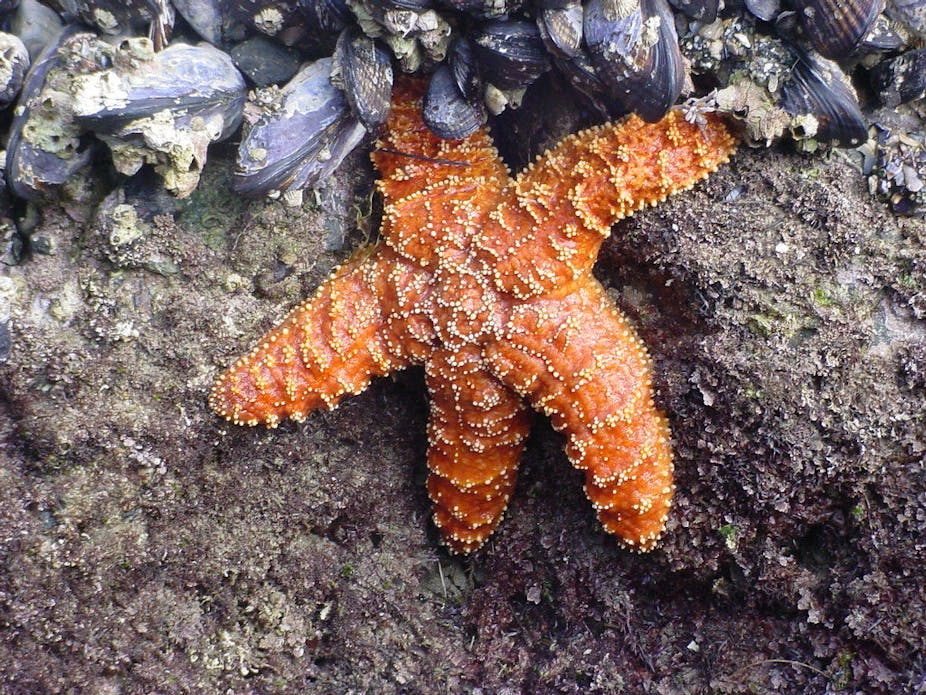Starfish along much of the North American Pacific coast are dying in great numbers from a mysterious starfish wasting syndrome. As yet the cause of the syndrome is unidentified, and it’s not clear whether it’s a due to an environmental change, disease or or something else.
The early signs vary by species affected and include a deflated appearance, unnatural twisting of the body, and small lesions on the surface that increase in size and number. The wasting often progresses rapidly, leading to the softening of the starfish’s hard body, loss of arms, and eventually complete disintegration and death, sometimes over a period as short as few days. Similar die-offs have occurred before in the 1970s and the 1990s, but never before at this magnitude and over such a wide geographic area.
The current bout of this wasting syndrome was first noted in ochre stars (Pisaster ochraceus) in June 2013 along the coast of Washington state during monitoring surveys conducted by researchers from Olympic National Park. As ONP is part the Multi-Agency Rocky Intertidal Network (MARINe), a long-term monitoring effort that extends down the whole west coast, researchers from Alaska to California were quickly alerted.
A spreading plague
The majority of early observations were made in intertidal (tidepool) habitats and as a result most of the early reports were for ochre stars, the most common in the habitat, but others species affected include the mottled star (Evasterias troschelii), leather star (Dermasterias imbricata), and six-armed stars (Leptasterias).
In August, divers investigating subtidal habitats reported massive die-offs of sunflower starfish (Pycnopodia helianthoides) just north of Vancouver, British Columbia. Shortly afterwards, other subtidal sea star species in the region began showing signs of wasting. During October and November, a similar mass death of starfish occurred in Monterey, California, with another die-off of sunflower and ochre stars around Seattle, Washington, with the syndrome spreading throughout the Puget Sound.

In mid-December, substantial numbers of wasting starfish were spotted around southern California. By the turn of the year it had been reported in 45 of the 84 MARINe sites from Anchorage to San Diego sampled since that summer, and in the last few months it has spread to Mexico and parts of Oregon, which had previously been unaffected. It is also intensifying, appearing at additional sites in those regions already affected.
Making sense of the evidence
In subtidal habitats, the sunflower star is typically the first species to succumb, followed by the rainbow star (Orthasterias koehleri), giant pink star (Pisaster brevispinus), giant star (Pisaster giganteus), mottled star, ochre star and sun star (Solaster), leather star (Dermasterias imbricata), vermilion star (Mediaster aequalis), six-armed stars, and bat star (Patiria miniata).
We don’t know whether the syndrome spreads sequentially from one species to the next, or if some species simply take longer to express symptoms, but the usually large populations of ochre and sunflower stars have experienced massive, geographically expansive (if patchy) and well-documented declines. Other species are less abundant, so the impact of the syndrome is not as clear.
Ecologists consider both sunflower and ochre stars to be keystone species because they have a disproportionately large influence on other species in their ecosystem. In fact it was ochre stars that Robert Paine experimented on when he coined the term keystone species in 1969. After removing many ochre seastars, a voracious predator of mussels, from his test area, he found that mussels out-competed other species and dominated areas where previously many species were attached to the rocky shore. Hence seastars were necessary to maintain the species composition.
So it’s anticipated that the sheer number of starfish of different species that have died may lead to radical change the seascapes in the subtidal (below the tidal line) and intertidal (between high and low water marks) zones. This is what has occurred after widespread death of particular marine species on previous occasions, resulting in dramatic ecosystem-wide changes.
What we know
From extensive samples collected researchers have begun to identify the agent behind the syndrome, and the environmental conditions that may have led to the outbreak. One of the top priorities is to confirm that an infectious agent is involved, and if so what it is. Molecular sequencing work of samples is underway at Cornell University to identify possible viruses and bacteria that could be causative agents. Current thinking is that there is an infectious agent involved, likely a pathogen. Importantly there is no evidence at all that links the current wasting event to the ongoing disaster at the Fukushima nuclear facility in Japan.
Long-term monitoring by MARINe groups and other partners along the entire west coast provides the information to compare distributions of different starfish species over 30 years.
MARINe has also developed a tracking log that can be downloaded from the seastarwasting.org website, which researchers, divers, and members of the public can use to report their observations, gathering information to help identify further outbreaks.

